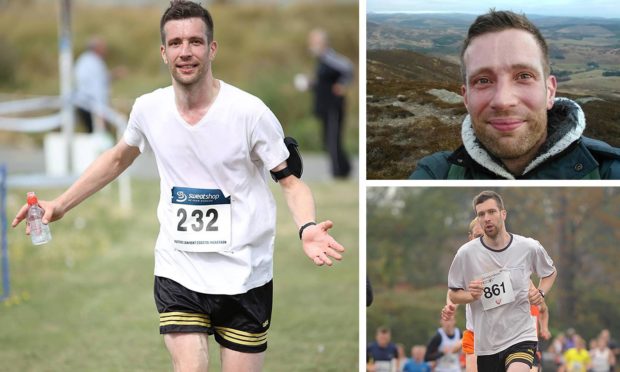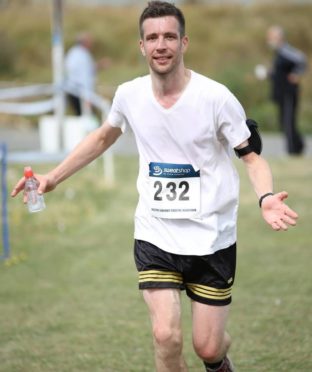Stephen Eighteen’s life changed with the arrival of a simple pet food delivery.
A keen runner, Stephen was gearing up to take part in his sixth marathon of 2013 when his future in the sport was suddenly called into question.
The Alyth man explains: “I’d trained up really well four days a week. About three days before the marathon I got a dog food delivery. I picked it up and felt my back go.
“It was really difficult because it didn’t shift. I played squash the next day and it was very painful. But I felt I’d trained so hard for the marathon and I wanted to do it in under three hours.
“Idiotically, I ran it. For the first half I was OK and I was on course to do it in the time I wanted to. But the second half was really painful and I got a stitch which had never happened before.
“I ended up hobbling back. It was awful. I did it in three hours and 21 minutes, even though I was walking for the second half. I’ve never been right ever since.”
Shock diagnosis
Stephen was diagnosed with spondylolisthesis, a condition where one of the bones in the spine slips out of position.
Athletes are more likely to develop the condition but it affects 4% to 6% of the adult population.
Stephen remembers: “At the time an osteopath told me I’d never do impact exercise again. Running was my big thing but I also enjoyed tennis and squash. I’d never be able to do any of these things again apparently.
“Personally, one of the worst things I can do is standing still for any length of time. Even now it’s something I really can’t do. I also can’t hold heavy backpacks for any length of time.”
‘Hillwalking is better than any physio’
Thanks to the help of medical professionals, Stephen now has a personal regime of low-intensity exercises designed specifically to help his back pain.
But, unable to return to the sports he loved, Stephen swapped his trainers for hiking boots, which has also had a surprising effect.
Stephen says: “One of the best things I’ve found is hillwalking. It’s probably better than any physio. I was in Switzerland in 2016 on a hillwalking holiday and I had a really scary experience where I had to call mountain rescue.
“Afterwards I was aching head to toe. I was in absolute agony everywhere – apart from my back. I’d been hillwalking every day and I had no back pain whatsoever.
“I was living in Kent at the time but because of everything I took to hiking a lot more. That’s what led me to Scotland really, because I travelled all around the UK doing loads of walking.
“I focused on that because it was something I could still do and it was good for my back. I ended up applying for jobs in places I could go walking. Then I got a job in Dundee and now I do a hill walk here every day.”
Meditation
Stephen has found a way to enjoy the benefits of physical exercise once again, without doing further damage to his back.
But he has also found mindfulness and meditation to be a big help in improving his back pain.
He continues: “A couple of years ago I started meditating, just as a way of relaxing and trying to clear my mind.
“I thought to myself ‘why don’t I visualise having a healthy strong back?’ Actually it seemed to work quite well.
“I don’t know if it’s just a coincidence or it’s because I’d had the condition for so long, but I did find I was able to go back to a bit of jogging. By the end of 2019 I was playing squash absolutely fine.”
While lockdown has curtailed the squash he now plays weekly at Blairgowrie Tennis Club.
‘Everyone’s back is different’
Stephen’s triumphant return to exercise proves there is hope for those living with back pain caused by the condition.
He says: “If, like me, people have had this diagnosis and have been told they can’t do any exercise now, there is hope.
“There is a way you can go back to exercising, maybe not as much as before, but maybe you can go back to a certain level. The key is knowing your back and knowing its limitations.
“It’s so important to find exercises that work for you. Exercising once in the morning and once at night is not easy and you just have to find something you know you’re going to stick to. I’m going to do this for the rest of my life.
“It’s kind of like mental health in that everyone’s mind is different. Different things work for different people and it’s exactly the same with your back.”



